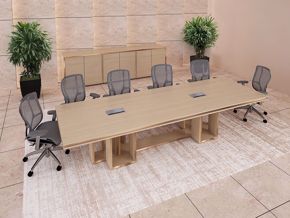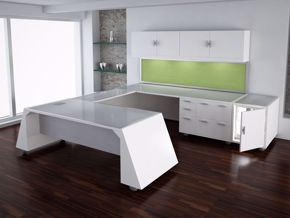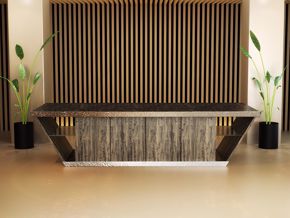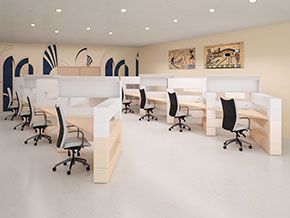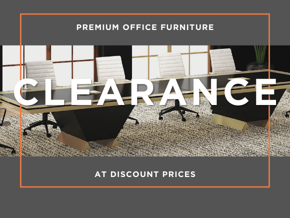Sure, you know the obvious answers, but...
Let’s talk about your dollars—the ones you’ve worked your a** off for. Imagine, for a moment, that real green money in a shopping cart, sitting beside another cartload that you are about to swap for a reception desk. Let’s look at the exchange in closer detail, and see if you really want to make that trade. In the end, I promise you; you will save some money—or, at the very least, gain a different perspective on how you want to spend the dollars you have. Sound fair?
Let’s be real here! Other than me, few people give a flying crap about understanding office furniture—at least until they’re next in line to buy it. Then they want as much information as they can get, as quickly as possible, and they’re done…until next time, that is. The problem is, while the internet is chock-full of information about lots of stuff, no one gives you the “real individuals” on what to look for when you are buying a reception desk.
That’s why uncertainty is not your fault. Yeah, sure, you’re going to see beautiful pictures and low prices. Internet marketers hope you’ll put something in your cart and be on your way. When it comes to explaining why a price is what it is, or how to lower it and get a better value, there are no answers, because it’s only about margin. That’s not good enough. Smart people want real answers.
Most uninformed, do-it-yourself office designers shopping the internet tell me they have three top priorities: 1) the style of furniture that first catches their eye; 2) pricing that fits their predetermined budget; 3) a delivery date that matches their schedule. Smart shoppers want more information than the average person, though, because they know the value of a great first impression.
Being able to evaluate your new reception desk without seeing it, touching it, or comparing it side-by-side with others is the plight of the internet shopper. You’re left to use your imagination. That’s where problems come in. If you don’t know what to look for, you are a mistake waiting to happen.
I’m here to help you come up with the right questions to ask yourself—and the seller.
1. Matching the “Spend” with the Impression Level
DIY designers seldom seem to get clear on what they need to do (and spend) to achieve the impression they need to make for their business; most make random selections.
The greatest asset any business can gain is customer trust. Some of this trust can be earned visually, and the amount required can vary from one company to another. Spending a dollar for to influence customer choice creatively candy bar at a local convenience store, for example, requires almost zero customer risk. Conversely, asking a client to invest their life savings in your company increases the risk/trust ratio substantially. All DIY designers need to evaluate the impression requirement before spending a dime. A business that looks visually unworthy of handling a client’s portfolio, or one that lacks enough creative expression for the business they’re going after, may fail the trust test.
Even if it’s only in a TV commercial, a DJ dressed in a quality suit with a corporate haircut, positioned in a quality office environment, can gain the trust of clients.
The ability of your reception area to speak to the confidence level your business demands is the first thing to determine in your spending.
The wrong choice will waste your dollars—before and after.
2. Evaluating a One-Piece Reception Desk versus a Multi-Piece Desk
Virtually no one makes solid, one-piece reception desks anymore—except for 90 Degree Office Concepts, that is. The market is saturated with knocked-down office furniture that requires labor-intensive assembly. A one-piece reception desk, solidly made in the factory that requires no parts to put together results in no precious hours for two or more people taking time away from real business to assemble furniture at a rate of x dollars per hour. What’s the value in that? If that’s not enough, what about the value and quality of furniture fitted together properly in the factory by a skilled craftsman, as opposed to an office assistant? What value can you put on a reception desk made from non-flexible parts that can’t wear and loosen? What value can you put on time savings, convenience, and expert precision?
The initial cost doesn’t equal total cost.
3. Evaluating Fit versus Function
Few people ever consider the hidden value of fit and function. Most businesses have a pre-planned amount of work that needs to be done by a certain number of people, within a fixed amount of space at the reception station. If you unknowingly sacrifice productivity because your reception desk is not the right size for the people, space, or activities you require, what will that cost you?
What if the reception desk you’re thinking of is too small, too big, or configured wrong for the job required or the space you have? What will that cost in time and organizational loss? What will that waste of space cost in unproductive rent dollars or building costs?
The wrong tools for any job equal added costs.
4. Evaluating Core Materials against Cost
Let’s compare prices. Picture two reception desks side by side and the price of one is much less than the other. The first thing you need to look at is the strength of their core materials. Why is that important? First, the strength and durability of your reception desk begin at its core—the foundation, if you will. Lower-priced furniture will almost always have some derivative of compressed wood at its core. The potential breakaway of fasteners from pieces of wood that are compressed together is much greater than that of real wood or plywood. The lower the density of the core materials, the lower the integrity of your reception desk.
Your selection of core materials will usually go directly to replacement costs and product wear.
5. The Hidden Dollars in Your Creative Workspace
Your workplace reception area has a voice. Even though you can’t physically hear it, it’s saying a lot about your company. A creative reception area will speak immediately to the innovative nature of your business. Here are a few more dollar-generating rewards:
• People tend to listen more carefully to your ideas because they trust your creative solutions.
• Customers appreciate you and want to hear your thoughts.
• You are trusted to do your work your way, without scrutiny.
• Customers will encourage you to be experimental.
• Creative environment dollars go unnoticed in your bottom line.
6. Gaining value from brand personality
In years past, when we thought of creativity, it was limited to the arts: painting, music, literature, etc. Today, this creative impetus extends to business. It is crucial that every company establish a brand personality: the ability to create a product/company identity that differs from competitors in the minds of customers. In this context, creative brand personality will help drive brand separation.
Brand separation, in every way and for companies of all sizes, is an important major-league reason for identifying distinct ways to creatively influence customer choice. Showing personality the moment customers walk into your workplace is a great way to extend your value proposition.
Expression of business creativity represents a real way to create brand separation.
7. Lowering Reception Desk Cost while Increasing Value
It’s true— with so many things to consider, shopping the internet for a low-priced reception desk that provides extreme value for your company is not easy. Often, low price and high value can work in opposite directions.
The idea behind building an effective reception area is not to find the lowest price, but rather to build the most value into your company.


